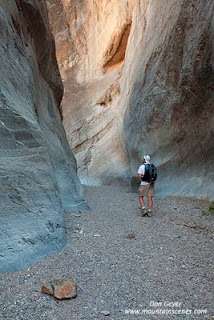 |
| Hiking Fall Canyon. |
The trail starts from the parking lot at the base of Titus Canyon, where the road is gated for one-way traffic coming the other way. The trail leaves to the north and traverses to the wide fan of Fall Canyon, with excellent views down to the valley below along Scotty's Castle Road.
From its mouth, Fall Canyon is a deep gorge with amazing walls. The canyon gets deeper and the walls more and more impressive the further into the mountain you go.
At several places within the first 3 miles, the wash squeezes through impressive narrows that force one to crane their necks to the walls above. The canyon walls climb vertically for hundreds of feet, and are topped by even higher walls. Vertical compositions work well at these spots. I also recommend a warming filter.
 |
| Hiking Fall Canyon in Death Valley National Park. |
At about 2.5 miles, the canyon is blocked by an 18 foot fall that poses a considerable challenge to the best of rock climbers. This is a very scenic spot for photography of the steep walls and seemingly insurmountable fall. Seemingly? Yes, there is an easy way around. Simply backtrack about 300 feet to find a path climbing upward to the south. It climbs steeply up a chimney to the south, then mellows out as it climbs a ledge over a high spot and descends down to above the fall.
The next third of a mile contains the tightest narrows of the canyon, and are very photogenic. The deep, dark, polished rock through this windy passage is extremely scenic, and the best part of hike!
I recommend focusing on vertical compositions to capture the feel of the towering walls above. I believe that adding a subject matter for purpose of scale also works well. Abstract patterns in the rock can also be played with. Normal and wide-range lenses work well here.
At a quarter mile above the first fall, the canyon opens up until mid-canyon is reached in about 3.5 miles. I did not venture up to mid-canyon, but have friends that thoroughly enjoyed it as a backpack (and continued further). The lower canyon makes for an excellent half day excursion with endless photography opportunities. Which ever way you choose to enjoy this area, do just that - enjoy!
If you wish to view more images from this area, feel free to visit my Death Valley gallery.
If you wish to view more images from this area, feel free to visit my Death Valley gallery.

No comments:
Post a Comment